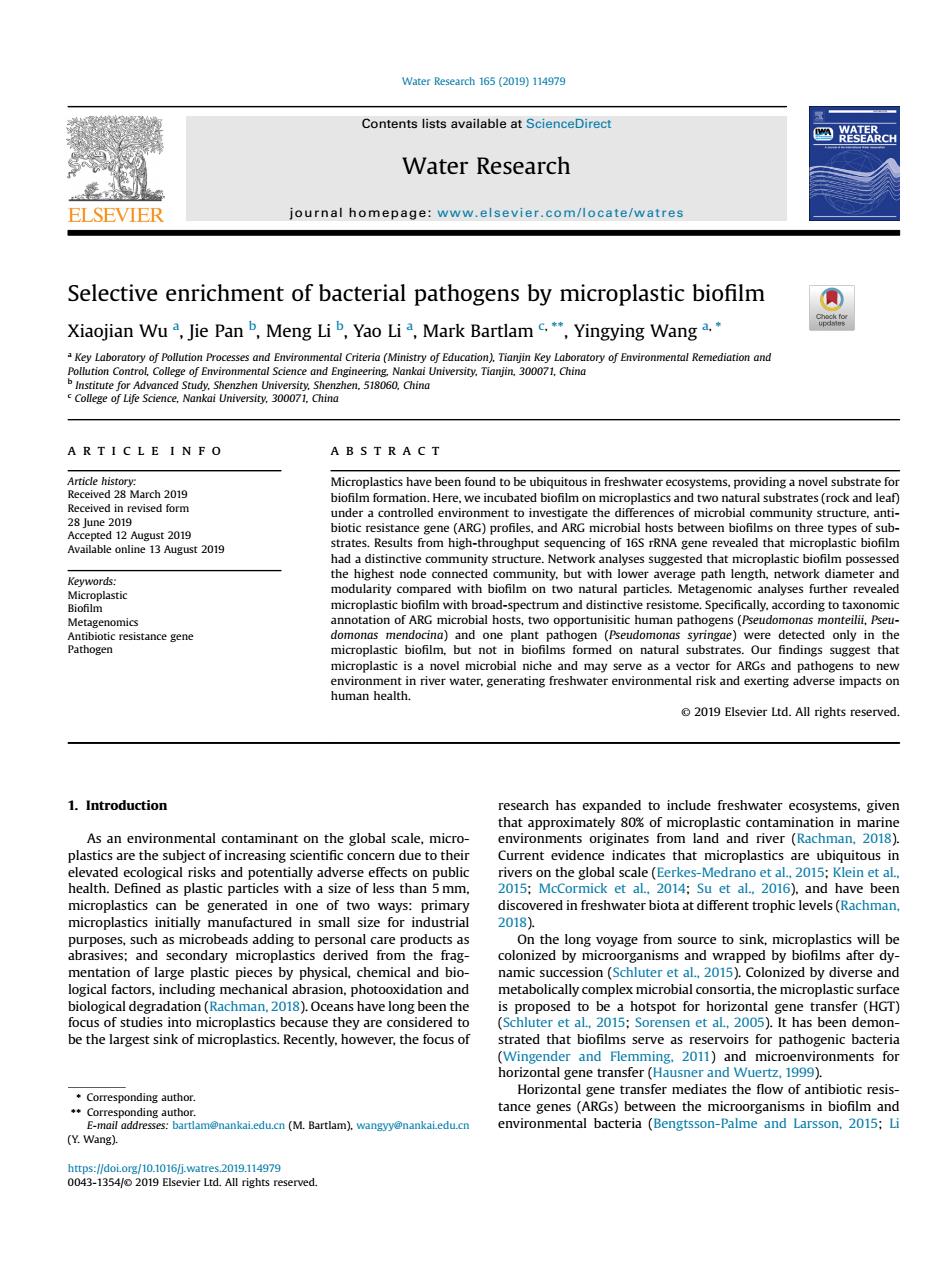正在加载图片...

Water Research 6 ()11497 Contents lists available at Water Research ELSEVIER journal homepage:www.elsevier.com/locate/watres Selective enrichment of bacterial pathogens by microplastic biofilm Xiaojian Wu,Jie Pan.Meng Li,Yao Li,Mark Bartlam.Yingying Wang ARTICLE INFO ABSTRACT roplastics have been found to be ubiquitous in freshwat er ec bioti ARG) and ARG ture.N the high. itic human pa plastic biofilm microplastic human health. 2019 Elsevier Ltd.All rights reserved 1.Introduction levatedccolog isks and ted in one of tw ways: vered in freshwater biota atdffert trophic evels( brasives:and co (Y.Wang) nankai.edu.cn(M.Bartlam).wangyySelective enrichment of bacterial pathogens by microplastic biofilm Xiaojian Wu a , Jie Pan b , Meng Li b , Yao Li a , Mark Bartlam c, **, Yingying Wang a, * a Key Laboratory of Pollution Processes and Environmental Criteria (Ministry of Education), Tianjin Key Laboratory of Environmental Remediation and Pollution Control, College of Environmental Science and Engineering, Nankai University, Tianjin, 300071, China b Institute for Advanced Study, Shenzhen University, Shenzhen, 518060, China c College of Life Science, Nankai University, 300071, China article info Article history: Received 28 March 2019 Received in revised form 28 June 2019 Accepted 12 August 2019 Available online 13 August 2019 Keywords: Microplastic Biofilm Metagenomics Antibiotic resistance gene Pathogen abstract Microplastics have been found to be ubiquitous in freshwater ecosystems, providing a novel substrate for biofilm formation. Here, we incubated biofilm on microplastics and two natural substrates (rock and leaf) under a controlled environment to investigate the differences of microbial community structure, antibiotic resistance gene (ARG) profiles, and ARG microbial hosts between biofilms on three types of substrates. Results from high-throughput sequencing of 16S rRNA gene revealed that microplastic biofilm had a distinctive community structure. Network analyses suggested that microplastic biofilm possessed the highest node connected community, but with lower average path length, network diameter and modularity compared with biofilm on two natural particles. Metagenomic analyses further revealed microplastic biofilm with broad-spectrum and distinctive resistome. Specifically, according to taxonomic annotation of ARG microbial hosts, two opportunisitic human pathogens (Pseudomonas monteilii, Pseudomonas mendocina) and one plant pathogen (Pseudomonas syringae) were detected only in the microplastic biofilm, but not in biofilms formed on natural substrates. Our findings suggest that microplastic is a novel microbial niche and may serve as a vector for ARGs and pathogens to new environment in river water, generating freshwater environmental risk and exerting adverse impacts on human health. © 2019 Elsevier Ltd. All rights reserved. 1. Introduction As an environmental contaminant on the global scale, microplastics are the subject of increasing scientific concern due to their elevated ecological risks and potentially adverse effects on public health. Defined as plastic particles with a size of less than 5 mm, microplastics can be generated in one of two ways: primary microplastics initially manufactured in small size for industrial purposes, such as microbeads adding to personal care products as abrasives; and secondary microplastics derived from the fragmentation of large plastic pieces by physical, chemical and biological factors, including mechanical abrasion, photooxidation and biological degradation (Rachman, 2018). Oceans have long been the focus of studies into microplastics because they are considered to be the largest sink of microplastics. Recently, however, the focus of research has expanded to include freshwater ecosystems, given that approximately 80% of microplastic contamination in marine environments originates from land and river (Rachman, 2018). Current evidence indicates that microplastics are ubiquitous in rivers on the global scale (Eerkes-Medrano et al., 2015; Klein et al., 2015; McCormick et al., 2014; Su et al., 2016), and have been discovered in freshwater biota at different trophic levels (Rachman, 2018). On the long voyage from source to sink, microplastics will be colonized by microorganisms and wrapped by biofilms after dynamic succession (Schluter et al., 2015). Colonized by diverse and metabolically complex microbial consortia, the microplastic surface is proposed to be a hotspot for horizontal gene transfer (HGT) (Schluter et al., 2015; Sorensen et al., 2005). It has been demonstrated that biofilms serve as reservoirs for pathogenic bacteria (Wingender and Flemming, 2011) and microenvironments for horizontal gene transfer (Hausner and Wuertz, 1999). Horizontal gene transfer mediates the flow of antibiotic resistance genes (ARGs) between the microorganisms in biofilm and environmental bacteria (Bengtsson-Palme and Larsson, 2015; Li * Corresponding author. ** Corresponding author. E-mail addresses: bartlam@nankai.edu.cn (M. Bartlam), wangyy@nankai.edu.cn (Y. Wang). Contents lists available at ScienceDirect Water Research journal homepage: www.elsevier.com/locate/watres https://doi.org/10.1016/j.watres.2019.114979 0043-1354/© 2019 Elsevier Ltd. All rights reserved. Water Research 165 (2019) 114979